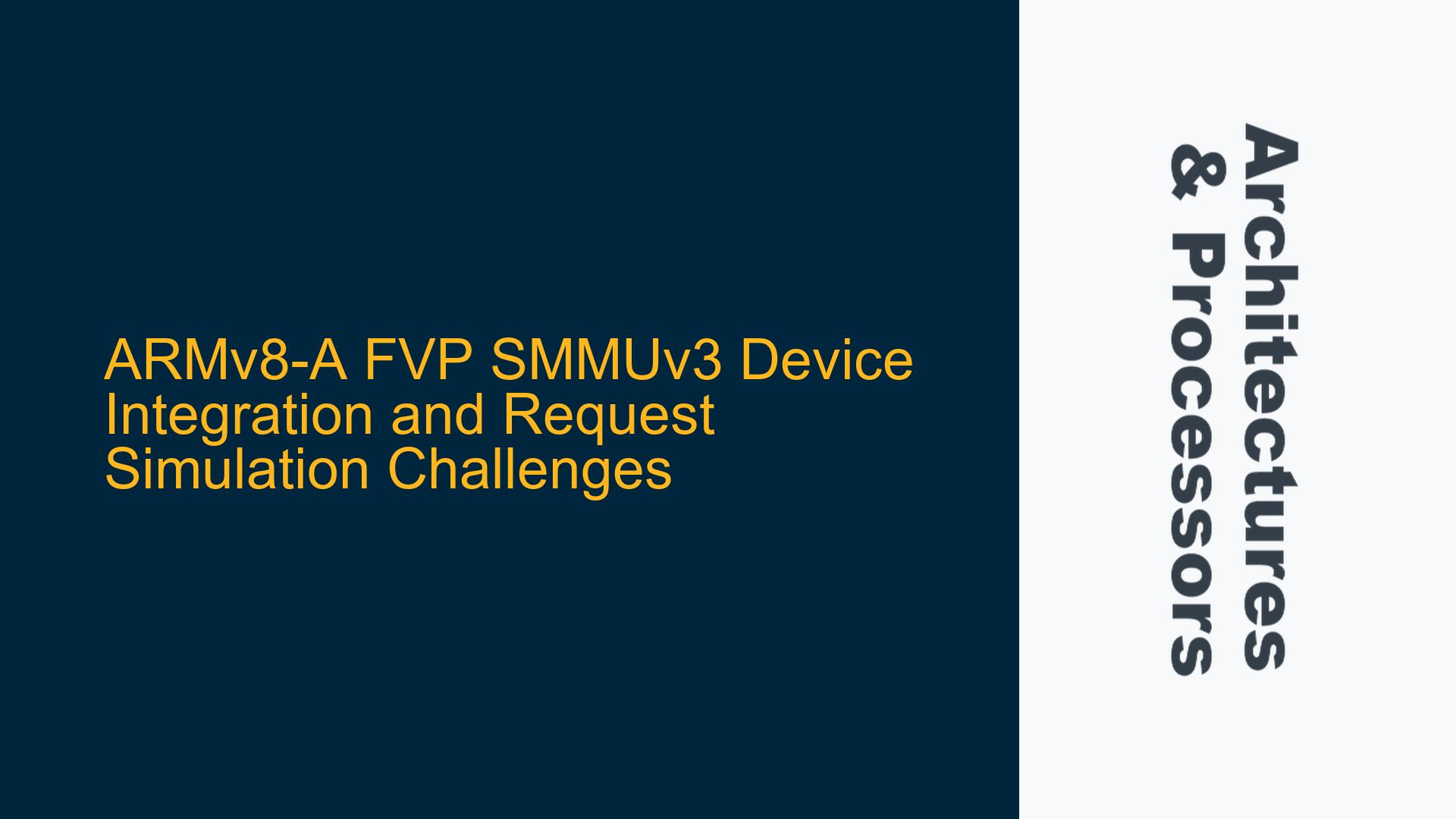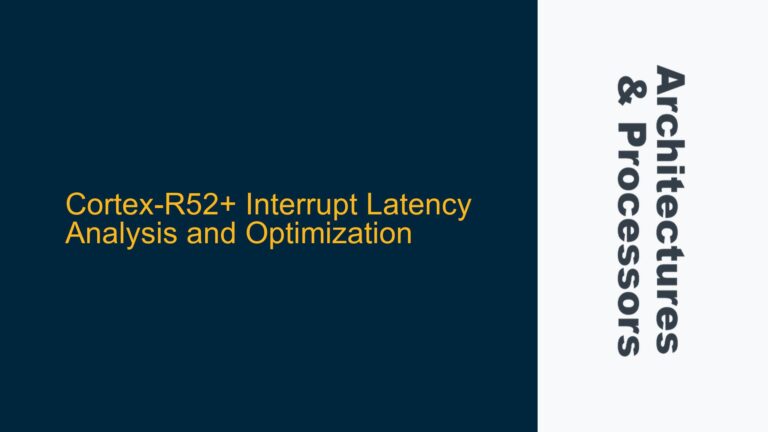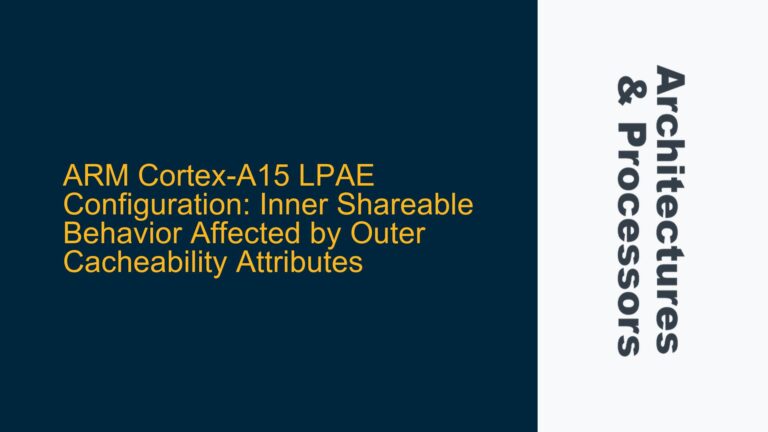ARMv8-A FVP SMMUv3 Device Integration and Request Simulation Challenges
SMMUv3 Device Integration and Request Simulation in ARMv8-A FVP
The integration of devices behind the System Memory Management Unit version 3 (SMMUv3) in an ARMv8-A Fixed Virtual Platform (FVP) presents a complex challenge, particularly when attempting to simulate device requests through the SMMUv3. The SMMUv3 is a critical component in ARM-based systems, providing memory management and address translation services for devices that are not directly connected to the CPU. This functionality is essential for ensuring that devices can access memory in a coherent and secure manner, especially in systems with multiple masters and complex memory hierarchies.
The primary issue revolves around the creation and simulation of devices behind the SMMUv3 within the ARMv8-A FVP environment. The FVP is a simulation platform that models ARM-based systems, allowing developers to test and verify their designs before committing to hardware. However, the FVP’s default configuration does not readily support the creation of custom devices behind the SMMUv3, nor does it provide an easy mechanism for these devices to generate requests that pass through the SMMUv3.
This limitation is particularly problematic for developers who need to test and verify the behavior of their SMMUv3 configurations, as well as the interactions between the SMMUv3 and the devices it manages. Without the ability to simulate these interactions, it becomes difficult to identify and resolve potential issues related to address translation, memory access permissions, and device isolation.
SMMUv3 Test Engine and Configuration Limitations
The root cause of this issue lies in the configuration options available within the ARMv8-A FVP. While the FVP provides a comprehensive set of tools for simulating ARM-based systems, it does not include built-in support for creating custom devices behind the SMMUv3. This means that developers must rely on external tools or custom modifications to the FVP to achieve the desired functionality.
One potential solution is the use of the SMMUv3 Test Engine, which is included in the FVP_Base_RevC-2xAEMvA configuration. The SMMUv3 Test Engine is a memory-based device that acts as a pseudo DMA controller, allowing developers to simulate up to 64 streams of requests through the SMMUv3. This engine is designed specifically for testing and verification purposes, making it an ideal tool for developers who need to simulate device requests behind the SMMUv3.
However, the SMMUv3 Test Engine is not without its limitations. While it provides a mechanism for generating requests, it does not offer the same level of flexibility as a custom-designed device. This can make it difficult to accurately model the behavior of specific devices, particularly those with complex access patterns or unique memory requirements. Additionally, the SMMUv3 Test Engine requires a custom Linux driver to operate, which adds an additional layer of complexity to the simulation process.
Another potential cause of the issue is the lack of documentation and examples for creating custom devices behind the SMMUv3 in the ARMv8-A FVP. While the FVP provides a wealth of documentation on its various components and configurations, there is limited guidance on how to extend the platform to support custom devices. This can make it challenging for developers to understand the necessary steps and requirements for integrating their devices into the FVP environment.
Implementing Custom Device Simulation with SMMUv3 Test Engine
To address the challenges of simulating devices behind the SMMUv3 in the ARMv8-A FVP, developers can follow a series of steps to implement custom device simulation using the SMMUv3 Test Engine. These steps involve configuring the FVP, developing a custom Linux driver, and integrating the SMMUv3 Test Engine into the simulation environment.
The first step is to configure the FVP to include the SMMUv3 Test Engine. This involves selecting the appropriate FVP configuration (FVP_Base_RevC-2xAEMvA) and enabling the SMMUv3 Test Engine within the simulation environment. The configuration process may require modifying the FVP’s configuration files to ensure that the SMMUv3 Test Engine is properly initialized and connected to the SMMUv3.
Once the FVP is configured, the next step is to develop a custom Linux driver for the SMMUv3 Test Engine. This driver is responsible for interfacing with the SMMUv3 Test Engine and generating the necessary requests to simulate device behavior. The driver should be designed to support the specific requirements of the devices being simulated, including their memory access patterns and address translation needs. The Linux driver can be developed using the provided source code and documentation available at https://jpbrucker.net/git/linux/log/?h=sva/smmute.
After developing the custom Linux driver, the next step is to integrate the SMMUv3 Test Engine into the simulation environment. This involves loading the driver into the Linux kernel running on the FVP and configuring the SMMUv3 Test Engine to generate the desired requests. The integration process may require additional modifications to the FVP’s configuration files to ensure that the SMMUv3 Test Engine is properly connected to the SMMUv3 and that the generated requests are correctly processed.
Once the SMMUv3 Test Engine is integrated into the simulation environment, developers can begin testing and verifying the behavior of their SMMUv3 configurations. This involves running a series of tests to ensure that the SMMUv3 is correctly translating addresses, enforcing memory access permissions, and isolating devices as expected. The tests should cover a range of scenarios, including normal operation, error conditions, and edge cases, to ensure that the SMMUv3 is functioning correctly under all conditions.
In addition to using the SMMUv3 Test Engine, developers may also consider implementing additional verification strategies to further validate their SMMUv3 configurations. These strategies may include the use of formal verification tools, simulation-based testing, and hardware emulation. Formal verification tools can be used to mathematically prove the correctness of the SMMUv3’s address translation and memory access logic, while simulation-based testing can be used to validate the behavior of the SMMUv3 in a variety of scenarios. Hardware emulation can provide a more accurate representation of the final system, allowing developers to test their SMMUv3 configurations in a more realistic environment.
By following these steps, developers can effectively simulate devices behind the SMMUv3 in the ARMv8-A FVP and verify the behavior of their SMMUv3 configurations. While the process may be complex, the use of the SMMUv3 Test Engine and custom Linux driver provides a powerful toolset for testing and verifying the functionality of the SMMUv3 in a simulated environment.
Conclusion
The integration and simulation of devices behind the SMMUv3 in the ARMv8-A FVP is a complex but essential task for developers working on ARM-based systems. By leveraging the SMMUv3 Test Engine and developing custom Linux drivers, developers can overcome the limitations of the FVP and accurately simulate device requests through the SMMUv3. This process, while challenging, provides a robust mechanism for testing and verifying the behavior of the SMMUv3, ensuring that it functions correctly in a variety of scenarios. With the right tools and strategies, developers can confidently integrate and verify their SMMUv3 configurations, paving the way for the successful deployment of ARM-based systems.






